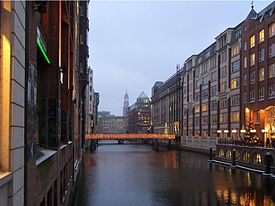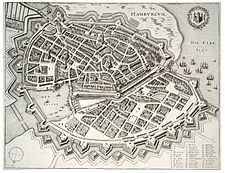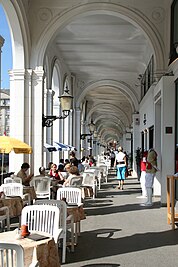world.wikisort.org - Germany
Neustadt (German: [nɔʏʃtat] (![]() listen), literally: "New town") is one of the inner-city districts of the Free and Hanseatic City of Hamburg, Germany.
listen), literally: "New town") is one of the inner-city districts of the Free and Hanseatic City of Hamburg, Germany.
Neustadt | |
|---|---|
 Bleichenfleet, one of the canals in Neustadt. In the background, the tower of St. Michaelis. | |
|
Flag | |
 Location of Neustadt within Hamburg-Mitte | |
| Coordinates: 53°33′7″N 9°59′8″E | |
| Country | Germany |
| State | Hamburg |
| City | Hamburg |
| Borough (Bezirk) | Hamburg-Mitte |
| Area | |
| • Total | 2.2 km2 (0.8 sq mi) |
| Elevation | 10 m (30 ft) |
| Population (2020-12-31)[2] | |
| • Total | 12,689 |
| • Density | 5,800/km2 (15,000/sq mi) |
| Time zone | UTC+1 (CET) |
| • Summer (DST) | UTC+2 |
| Dialling code(s) | 040 |
| ISO 3166 code | DE-HH |
| Vehicle registration | HH |
| Website | www.hamburg.de |
History
By 1529, Hamburg was firmly anchored in Lutheran Reformation and had successfully managed to divert its trade away from the Baltic to more dynamic markets along the Atlantic. Hamburg's economy boomed, between 1526 and 1551 the state budget tripled,[3] and the Hanseatic city had become a major trade and capital market.[4][5] Meanwhile, persecution of Protestants in the Low Countries, other parts of Germany, Portugal, Spain and various other parts of Europe caused an immense influx of religious refugees into Hamburg. Between 1500 and 1600, the population of Hamburg tripled to 40,000, surpassing Lübeck as largest German port city.[3]

In advance of the Thirty Years' War (1618–1648), the Hamburg Senate commissioned Dutch military engineer Johan van Valckenburgh to strengthen the city's defenses. The new Hamburg Ramparts (Wallanlagen) were also meant to meet demand for additional space to be within the city. When completed in 1626, the ramparts enclosed all of Altstadt, plus an almost equally large area west of it: the so-called Neustadt.
Neustadt was laid out in a mostly rectangular street grid, though not much of that is recognizable today. Additionally, three principal streets connected the old town (Alstadt) east of the Alster River with the two new city-gates out west. Each of these three streets was given a market square at half distance: Gänsemarkt in the northern Neustadt, Schaarmarkt in the southern Neustadt, and Großneumarkt in the very center. The northern Neustadt around Gänsemarkt became a quarter of the wealthy and well-off citizens. Later this area also developed into Hamburg's opera district, the area around Jungfernstieg eventually developed into an elegant shopping district. In contrast, many parts of the southern Neustadt became shady quarters of the port's workers. Up until the late 19th and early 20th century, Neustadt was famous for its many "Gängeviertel": quarters with narrow alleys (Low German: Gänge).[6] In 1893 Neustadt was ravaged by a Cholera epidemic. Due to continuing, unsustainable hygienic conditions, by the 1960s most of the Gängeviertel were demolished.
Geography
Neustadt is bordered by Binnenalster and Alster (i.e. Alsterfleet) to the East, Elbe to the South, and the former Wallanlagen (now made up by a string of parks) to the West and North-west; among those: Planten un Blomen. Except for the blocks around Fleetinsel and the Alster's canals in the eastern part of the district, most of Neustadt lies on a geest slope above the Elbe. Districts bordering Neustadt are (starting clockwise in the West/North-west): St. Pauli, Rotherbaum, Altstadt and HafenCity.

Subdivisions

For statistical and planning purposes, Neustadt has four designated localities (German: Ortsteile) and quarters (German: Viertel, or specifically used in Hamburg: Quartier); however not recognized as administrative subdivisions.
| Map | Locality | Quarter | Description |
|---|---|---|---|
| 104 | Südliche Neustadt Southern Neustadt |
Residential district, in parts also mixed use centered around St. Michaelis and located between Elbe and Ludwig-Erhard-Straße; includes the Portugiesenviertel | |
| 105 | Nördliche Neustadt Northern Neustadt | Mixed use district located between Ludwig-Erhard-Straße and Kaiser-Wilhelm-Straße; includes Großneumarkt and the Composers Quarter.[7] | |
| 106 | Fleetinsel and adjoining blocks | ||
| 107 | Opern-Quartier | Theater and shopping district - including Colonnaden street - nestled between Gänsemarkt, the Binnenalster at Neuer Jungfernstieg and Ring 1 along Planten un Blomen near Stephansplatz. Named after the Hamburg State Opera (Staatsoper). | |
| Passagenviertel | Shopping district stretching from Jungfernstieg and the Binnenalster to Stadthausbrücke, bordered by Alsterfleet and Gänsemarkt. Named after the many shopping passages (malls). |
Streets and squares
On its western and north-western borders, Neustadt is encircled by "Ring 1" (Holstenwall, Gorch-Fock-Wall, Esplanade), an 1880s-built ring road continuing into Altstadt. Ludwig-Erhard-Straße is a 1960s-built thoroughfare and part of Bundesstraße 4, crossing Neustadt midway from East to West.
- Peterstraße
- Gänsemarkt
- Große Bleichen
- Neuer Wall
- Alsterarkaden
Other notable streets are most of the shopping streets around Jungfernstieg and Gänsemarkt, and a couple of streets between St. Michaelis and the Elbe's embankment at Baumwall and Vorsetzen. Important squares in Neustadt include Johannes-Brahms-Platz, Gänsemarkt, Großneumarkt, Millerntorplatz, Schaarmarkt, Sievekingplatz, Stephansplatz, and Zeughausmarkt.
Culture
Landmarks and cultural heritage
Like neighboring Altstadt, Neustadt is packed with landmarks and cultural heritage.
The single most important landmark in Neustadt is the Church of St. Michaelis (St. Michael's), one of Hamburg's five Lutheran main-churches (Hauptkirchen). St. Michaelis became Neustadt's Lutheran parish in 1647, however only granted political rights in 1677, and permitted as college to the city's parliament in 1685. Other notable churches in Neustadt include four Nordic missions to seafarers: the Danish Seamen's Church Abroad (Benedikte), the Finnish Seamen's Mission, the Norwegian Church Abroad, and the Church of Sweden Abroad (Gustav Adolf), and the Anglican Church of England (St. Thomas Becket).
Up until the late 19th and early 20th century, Neustadt was famous for its many "Gängeviertel": quarters with narrow alleys (Low German: Gänge). However, due to unsustainable hygienic conditions, by the 1960s most of them were demolished. The Krameramtsstuben (Grocers' Apartments) are one of a few preserved examples of that time. At Rademachergang stands a fountain, dedicated to Hans Hummel (1787–1854), a former water carrier and one of Hamburg's beloved "Original(e)" (character(s)).
The Alsterarkaden is an open arcade, spanning some 200 m along the entire North-west side of Kleine Alster. Designed by Alexis de Chateauneuf (1799–1853) and built in the year after the Great Fire (1842), it was one of the first buildings in the redeveloped urban ensemble between Jungfernstieg and Rathausmarkt. Today they are center of the Passagenviertel.
The Hanseatic Supreme Court (Hanseatisches Oberlandesgericht, HansOLG) was founded in 1879 as the common supreme court of the three Hanseatic and republican city-states of Bremen (part of HansOLG until 1947), Hamburg (sole user today) and Lübeck (part of HansOLG until 1937). The courthouse at Wallanlagen was built between 1907 and 1912.
The Hübner Haus, an office building and former marzipan factory, café, and pastry shop, was the first concrete building erected in Hamburg when completed in 1909.
Museums and cultural institutions
- Museums
- Hamburg Museum
- Cap San Diego – Museum ship
- Rickmer Rickmers – Museum ship
- Music and performing arts venues
- State Opera (Staatsoper)
- Laeiszhalle
- Fliegende Bauten
- Opernloft
References
- No English language equivalent, literal translation: "city-part"
- "Bevölkerung in Hamburg am 31.12.2020" (PDF). Statistisches Amt für Hamburg und Schleswig-Holstein. 23 April 2021.
- Wiechmann, Ralf. "Hamburg im 16. Jahrhundert". Hamburger Reformation. Senat der Freien und Hansestadt Hamburg. Archived from the original on 3 April 2015. Retrieved 2 April 2015.
- Many foreign merchants and traders settled in Hamburg; among others, the Merchant Adventures of London in 1567.
- The Hamburg Stock Exchange was founded in 1558.
- Landesbildstelle Hansa Hamburg (2014). Hamburger Gängeviertel. Historische Ansichten. Hamburg: Diplomica Verlag GmbH. Retrieved 2 April 2015.
- Komponistenquartier, Komponisten-Quartier Hamburg e.V., Retrieved 2 April 2015.
External links
| Wikimedia Commons has media related to Hamburg-Neustadt. |
- Official website (in German)
- Images on bilderbuch-hamburg.de (in German)
На других языках
[de] Hamburg-Neustadt
Die Neustadt ist ein zwischen Hamburg-Altstadt und St. Pauli zentral gelegener Stadtteil im Bezirk Hamburg-Mitte der Freien und Hansestadt Hamburg.- [en] Neustadt, Hamburg
Другой контент может иметь иную лицензию. Перед использованием материалов сайта WikiSort.org внимательно изучите правила лицензирования конкретных элементов наполнения сайта.
WikiSort.org - проект по пересортировке и дополнению контента Википедии









